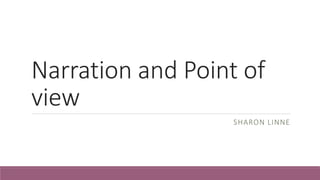
Point of view lecture
- 1. Narration and Point of view SHARON LINNE
- 2. What is Point of View? The point of view is the way the author wants you to understand the story. There are three types: First-person point of view Second-person point of view Third-person point of view
- 3. First-Person Point of View In the first-person point of view, the narrator (the person telling the story) is one of the characters of the story. This narrator will refer to himself/herself as “I” or “me” throughout the story. The reader experiences what the character experiences The reader is limited to what the narrator knows When a first-person narrator reveals his or her innermost thoughts through narration, it is called internal monologue.
- 4. Second-Person Point of View In the second-person point of view, the writer directly address the reader, referring to the reader as “you.” The effect of using the second-person point of view is that the reader is pulled into the story, making him/her feel like a participant. This form is rarely used in literature.
- 5. Third-Person Point of View In the third-person point of view, the narrator is simply the teller of the story. He/she is not a participant in the story. Characters are never referred to as “I,” “we,” or “you.” The writer has many options when using the third-person point of view. The narrator may be omniscient (or all-knowing), meaning the narrator knows the thoughts of all of the characters. An omniscient narrator also knows all of the events that are taking place. Narration that conveys the inner thoughts of a character through narration is called indirect free discourse. The narrator may be limited, meaning that the narrator only has insight into one character. When the narrator discusses the character’s thoughts, we hear the narrator’s voice, not the character’s.
- 6. Point of View Writers sometimes change the narrative perspective when writing. For example, William Faulkner’s novel As I Lay Dying alternates first-person narrators. One chapter may be written in the first-person point of view from Darl’s viewpoint, and the next chapter may be written in the first-person point of view from Dewey Dell’s viewpoint. Occasionally, a writer will use more than one point of view in the course of a novel. Barbara Kingsolver’s The Poisonwood Bible is written primarily in the first-person point of view, but it occasionally contain passages written in the third-person point of view.
- 7. Narrator Reliability It is important to consider the motivations of the narrator in telling the story. This will help us to assess how much to believe the version of events we are being told. If the narrator is unbiased and tells an accurate account of the events, he/she is a reliable narrator. If the narrator has some degree of bias, he/she is an unreliable narrator. There are two different types of unreliable narrators: A partially unreliable narrator is “one whose reliability we are never certain about” (Pike and Acosta, 2014, p. 130). Perhaps the narrator’s accounting of events contains some bias, but he/she is attempting to be truthful. A wholly unreliable narrator is one who cannot be trusted; he/she is telling a version of events that is not truthful.
- 8. Summary As you are reading, think about the narrator of the story. Is he/she a participant in the story? How much does he/she know about each character? Does he/she have a motive in telling you the story?